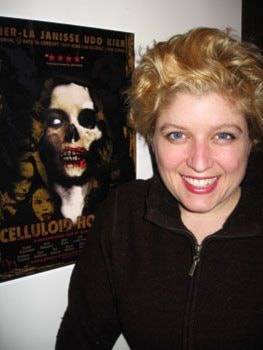When Lisa Steele and Kim Tomczak started making videos in the 1980s, they encountered more resistance than they expected.
The new medium wasn’t easily accepted.
People thought it was “boring,” “introspective,” “navel gazing,” said Tomczak.
It wasn’t art.
And that mindset continued for 20 years.
If you went to an art gallery and asked for a projector 10 years ago, they’d go into a tizzy, Tomczak added with a laugh.
Today things are different.
“It’s rare to have a show that doesn’t have a video component,” said Yukon Arts Centre public gallery acting curator Mary Bradshaw.
And the gallery’s current exhibition is no exception.
Steele and Tomczak were in Whitehorse this week to present two of their videos — We’re Getting Younger All the Time and Practicing Death — which will show at the gallery until the end of October.
“Having them up here is another example of how we’re so lucky,” said Bradshaw.
“They’re definitely pioneers of video work in Canada and internationally and they’ve reshaped how a lot of video distribution is done, especially on a smaller scale.”
And she hopes that bringing them to the territory will help Yukoners get their works shown down the line.
Tackling heavy themes, like Canada’s health system and the death penalty, Steele and Tomczak’s work critiques media and how it might distort reality.
“And we started out doing it in really clumsy, overt ways,” said Tomczak.
“At one point, Kim’s father watched one of the films and said, ‘You’d have to be dead not to get that,’” added Steele with a laugh.
“We’re called ‘utopians’ and we don’t disagree with that — it’s kind of an interesting word.”
In the early ‘80s, the pair began researching the video art scene in Canada.
There were other artists making similar videos, but there was little opportunity to get those works shown.
“You couldn’t see work; there was no place to look at it,” said Steele.
So they came up with an innovative solution — V-tape.
It began as a co-op where video artists worked to promote the work of other artists.
Now the Toronto-based organization has grown into an international institution.
V-tape is an alternative to commercial distributors, who are primarily interested in making money, and some other independent distributors, who peddle artists’ works for free.
V-tape gives nothing away for free.
“We believe artists should be paid for their work,” said Tomczak.
And unlike the larger commercial distributors, V-tape will work to get the videos shown in smaller venues like classrooms and museums — where artists can make $50 or $100 a pop.
“We’ll do that forever,” said Tomczak.
“The commitment is to the artist — what you’ll find, even with non-profit distributors, is that they’ll distribute a work of ours from 1982 and, by 1989, they sent the work back to us and ask for new work,” said Steele.
“At V-tape, it’s a very different commitment — we see ourselves as custodians of the work.
“This is an art form and it has to be available for looking at,” said Steele.
V-tape began with a dozen titles and now the collection holds more than 3,500, with hundreds more added each year.
It sends out hundreds of films and videos each year to programmers around the world.
“There’s one person on staff who just ships stuff,” said Tomczak.
“Long before the internet was even there, our information was computerized; it makes it more friendly to the programmer and means you can construct your own model for what you want.”
Search the keyword “Yukon” in V-tape’s online database and it returns two films by Teslin-based artist Carol Geddes.
V-tape has also started a program that teaches students from the digital generation to restore early forms of video, like reel-to-reel.
“A 20-year-old knows how to show videos on their iPod, but they don’t know how to work a VCR,” Tomczak added.
Currently they’re recovering on a lot of work that was made in the ‘80s and is now collapsing.
V-tape also runs a website at that acts as an intro to Canadian video art at http://videoart.virtualmuseum.ca — it also features a few clips from Steele and Tomczak’s videos.
Over years at the hub of the video art scene, they’ve watched it change.
They’ve seen interest in aboriginal work skyrocket over the past few years.
“They don’t necessarily have to be about aboriginal subject matter, although many are,” said Steele.
They’ve also seen works made in the ‘70s come back into vogue.
“You couldn’t give it away 15 years ago,” said Steele. “No one would watch it, you couldn’t pay people to watch it,” added Tomczak.
Solo and as a pair, Steele and Tomczak have staggering CVs. Their works are held in collections around the world.
On top of founding V-tape, they were also instrumental in starting the ImagiNATIVE Film and Media Arts Festival.
Now in its eighth season, the fest celebrates the work of indigenous film, video, radio and new media artists.
Currently, both work as professors at the University of Toronto’s visual studies department.
Their videos will share the Yukon Arts Centre Gallery with Philomena Carroll’s photographic series titled The Alchemist’s Jar and Laurie Papou’s new media work until October 28.
Contact Leighann
